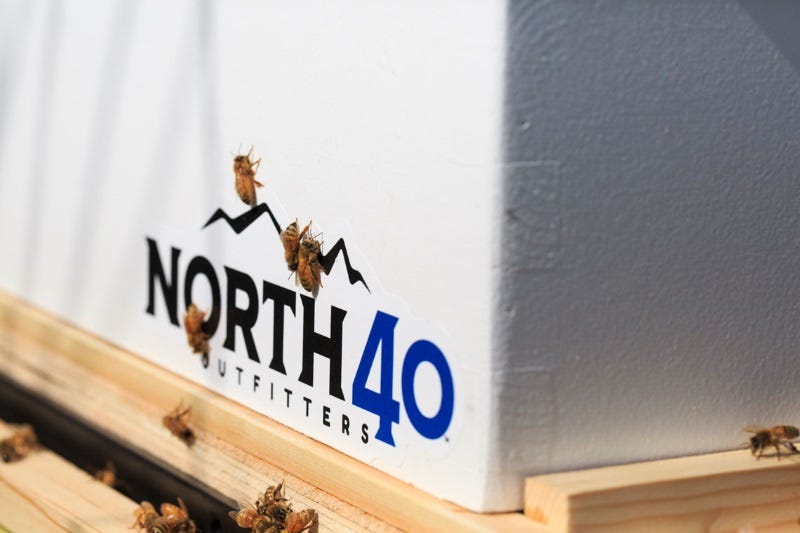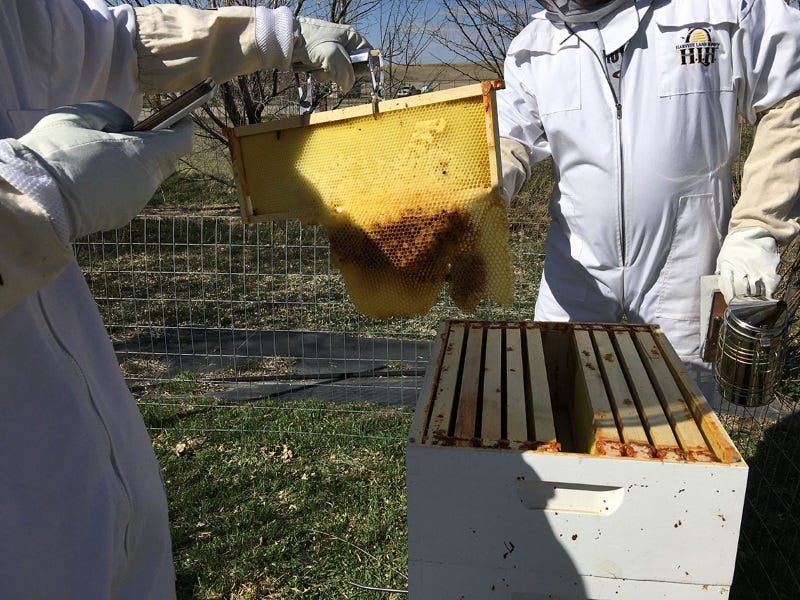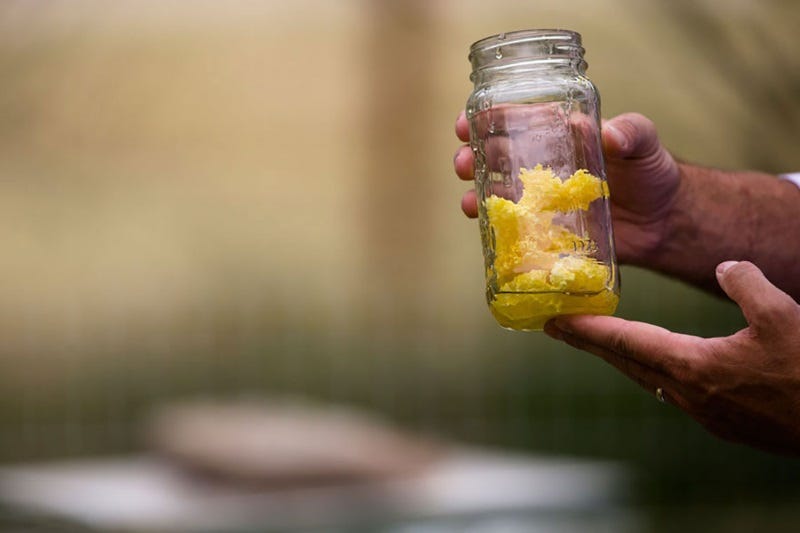First Year Beekeeper: A Complete Guide & Log of What to Expect
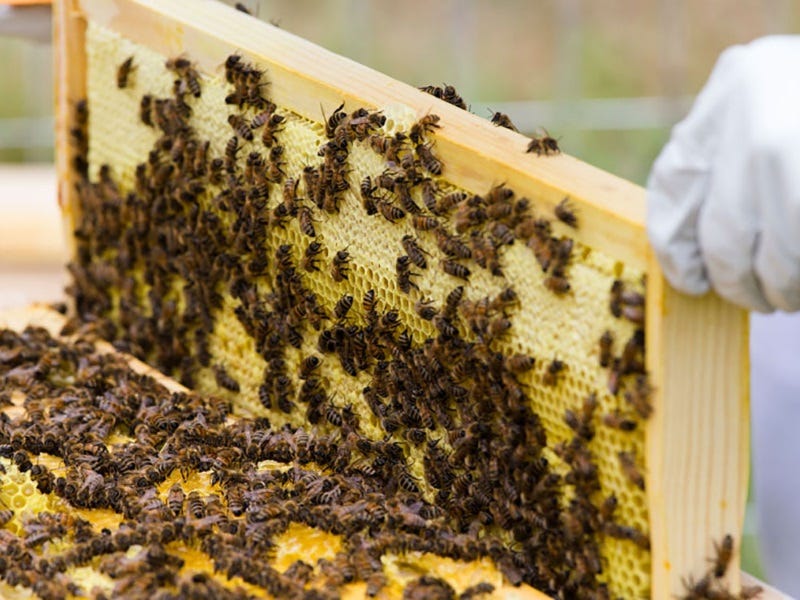
What do you Need? Starting Bees with North 40
This is one of the closest "full-service," starting bees resources you are going to find this year. From the best "bee" areas and brood boxes and supers to suits and smokers- this is it.
Well- first you need a clean, well-lighted place to put your bees. Well-lighted is usually an indication of flowering plants necessary for bees who survive on pollen from those flowers.
I guess well lighted is not a necessity- many plants and flowers grow in the shade. Your bees just need to have access to flowering plants the TYPES of flowering plants will affect your honey taste/color/bouquet, and that is awesome: fireweed honey, knapweed honey, clover honey- if you are a veteran beekeeper, what are your favorite honey types?
Want to know how a bee actually makes honey?
We've come across people who use GPS coordinates on their honey jars so they and their honey buyers will know EXACTLY where the honey they eat comes from also very cool.
As you can tell, we are into bees here at North 40- we started our own hive using bees from Polson, Montana and a brood box from Harvest Lane Honey. So, let's get into the equipment you will need.
You can order your brood box from us if you already have bees and are thinking about splitting your hive, or you can just get the full starter kit. It is a one-stop, inclusive kit for starting your first colony.
It includes a flat metal hive top to keep pests out, an inner hive top cover (which you can replace later with a queen extruder when you want to add supers), an inner hive feeder to help your bees transition, or to feed them through winter, frames, smoker, bee brush and so much more.
Also, something to think about a source of food to help your bees' transition from the long haul to their new home. There are feeders with cap and ladders systems you can buy or brood patties with the specific macro and micronutrient breakdowns to help your bees adjust to their new home.

Gear to Protect you Against Stings & Arrows of Outraged Bees
So, now you have your brood box or your complete starter kit- you've ordered your bees from a local supplier- they are on the way.
Now what? You are going to need some basic protective gear.
Also, side-note, don't be like Drew and Cutter and wear black shirts to pick up your bees. Where white. Trust us.
Basic protective gear includes a suit, gloves, and a mask. When moving bees or doing hive inspections, you will be required to lift the hive top off, use your smoker to drive the honey-engorged bees down to the bottom, and look around in your hive for parasites, honey production, and any myriad of other reasons- what's that mean?
It means unless you have the hardened skin of a black bear or grizzled bee veteran- you will want to avoid those stings you are sure to get when messing around with an empire of honey.
Never fear, we've got the gear to protect you and your un-grizzled body parts from those bee stings.
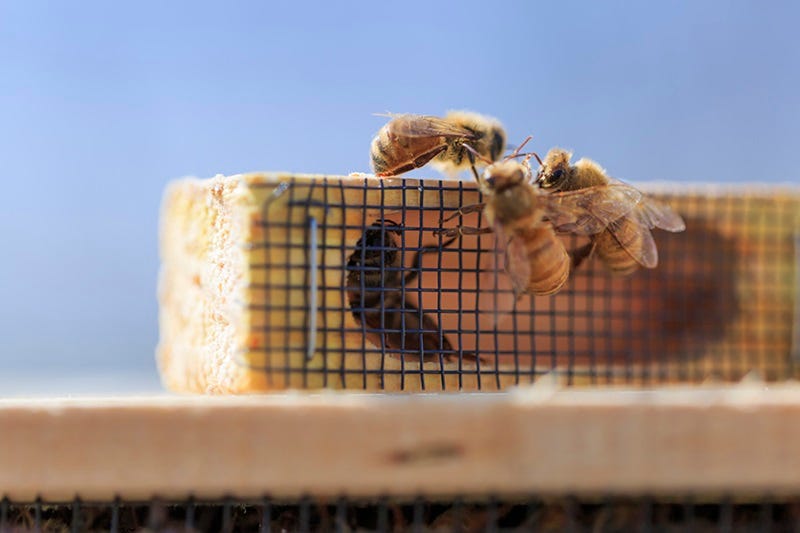
Beekeeping Equipment
The brood box is an absolute necessity for getting started. It is where your newly acquired queen bee will start her colony, her honey empire. When you transplant to a brood box, this is where all the new bees, from drones to nurse bees will live and work.
Get your brood boxes from us here.
And then check out what will happen INSIDE that brood box!!!
Upping your Bee Game: Add a Honey Super to your Hive
So, now- you've got your brood boxes, your queen and smokers, your suit and gloves- it's been a couple weeks/months (depending on rainfall and other environmental factors)- now what?
You'll need to add a super.
Now it's time to do your first hive inspection... if you order your complete beekeeping kit from us, it will come with the hive tool you will need to lift off the hive top, inner top and check the progress of your frames (you should probably wait AT LEAST two weeks to give your new colony ample time to expand into the brood chambers).
When you are looking to see if your brood box is successfully expanding, check the outside frames the colony will build from the middle out, so if those outside few frames are looking healthy and becoming full, you can go ahead and add a super to your brood box.
You will need a queen excluder to keep your matriarch in the brood chambers this will allow the worker bees to climb upwards and deposit honey.
The steps you see outlined above… well, we went out and actually put them into practice. So, if you are wondering what it is actually like to take action and become a hobbyist beekeeper.
Below you will find a firsthand account of how it went for us.
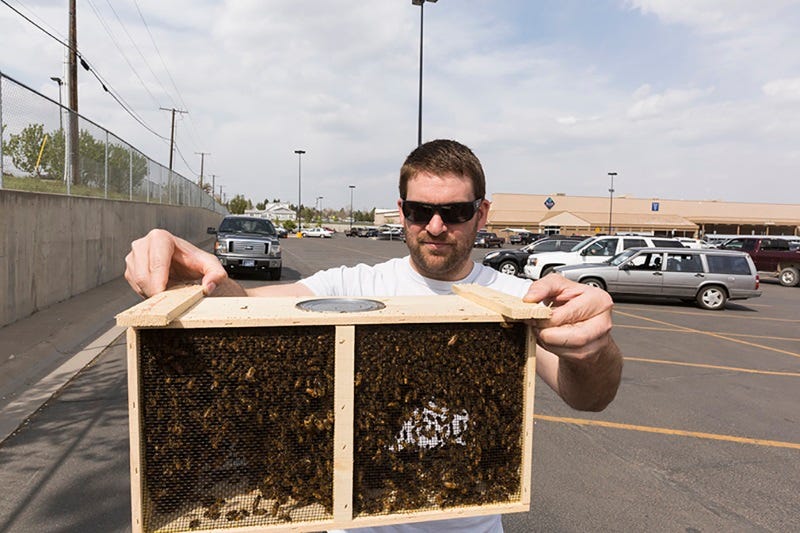
Our First Steps into the Realms of Beekeeping
You know that weird feeling you get when watching a tense part of a movie, or a YouTube video you know isn't going to end well? Yeah, that feeling where you want to yell at the guy jumping his bike off the house and into the kiddie pool? That's the feeling I had the other day when I willingly walked up to a swarm of bees, picked them up and put them in my truck... pretty sure I haven't been that nervous since 1988 when I went to my first day of Mrs. Grogan's Kindergarten class.
Want to know about Drew-the-Beekeeper? Read about Drew-the-Gardener here.
At first, handling bees seemed like a sketchy sort of business. With less than 24 hours' notice, we met a couple of random guys in a parking lot. They introduced themselves as Mike and Reese, whether or not that was their real name is still in question. Off to the side of their truck were a couple dozen screened boxes of bees.
Of course, with 30,000 bees locked up in little cages, there were a few hitchhikers that had made the journey from California on the outside of said screened boxes. I started to duck and weave as they buzzed around us to the amusement of "Reese." He kind of chuckled and told me to relax. Then, after looking me over, he said I probably shouldn't be wearing black. "Bees don't like black." So I took off my black coat and he chuckled again. "They don't like red either." I was starting to run out of layers, but luckily under my red plaid shirt was one last white layer!
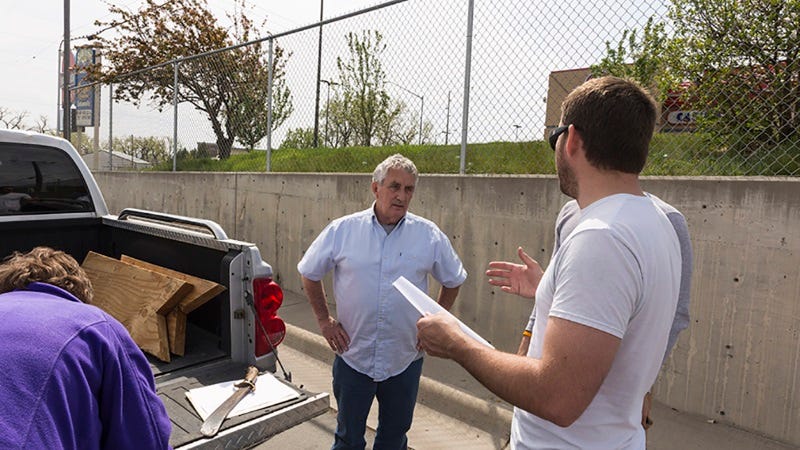
Picking up our New Package of Bees
The deal had already been paid for so all we had to do was pick a package of bees and head on down the road. Little did "Mike" know I had a lot of questions about all this bee business and little did I know that "Mike" was actually the Mayor of Great Falls! The deal was now starting to get a little less questionable.
I quickly got over the shame of not knowing the Mayor of my city and proceeded to ask Mayor Winters a bunch of rookie questions. After a brief round of "Q & A," we rounded up the convoy of North 40 vehicles and headed out of town to put our California bees in their new Montana home.
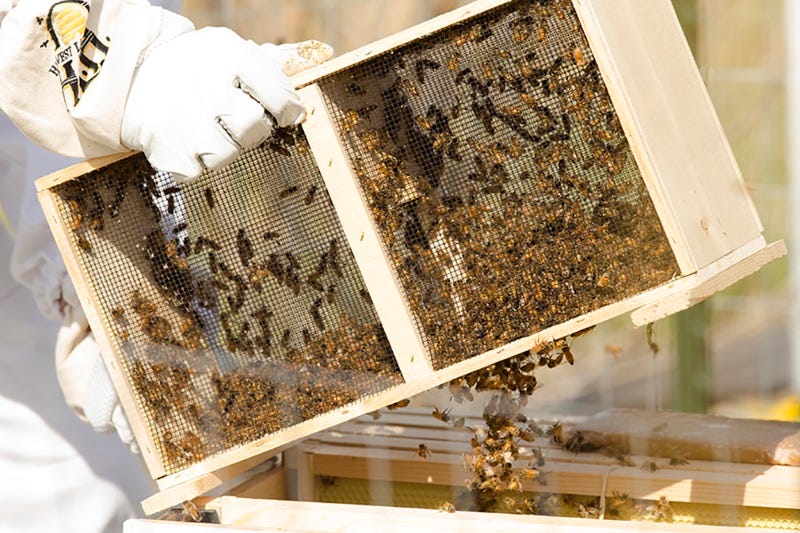
We introduce the Bees we to an Empty Hive Box
Usually introducing bees doesn't require two photographers and a social media person, unless of course, you work for North 40 Outfitters. In this instance, the rookie (me) is usually accompanied by a seasoned pro. Unfortunately, we don't have one of those on staff in our marketing department, but we did have a lot of guidance from a local beekeeper.
Although he wasn't there with us he did give us a lot of last-second pointers before we embarked on our bee adventure. Another great source of information has been from our local bee club. Although I haven't been to a meeting, I have kept up with all their questions and experience via their Facebook group. Turns out "Reese" really is Reese and we are both members of the Montana Beekeeping Forum. I guess this bee business really is legit.
These are the hives and frames we used during setup and introduction of our bees.
The process of introducing bees wasn't nearly as hard as I expected, in fact, it was quite easy. The most important part was being organized; we were about half organized.
Luckily for us, a 5th person showed up who wasn't Tweeting, filming, shooting pictures or deathly allergic to bees. Jacob turned out to be a lifesaver running around getting things I had forgotten or couldn't easily get to. Have you ever seen a small car full of clowns at the rodeo? Yeah, that basically described us.
Now the bees are in the hive, Jake avoided the emergency room and North 40 now has an operational beehive.
So why go through all this trouble when there are plenty of bee pictures and videos all over the internet? We wanted to go through this process so we could experience what you would experience as a novice beekeeper... and document it in an article like the one you are reading right now.
We are passionate about trying new things and encouraging our customers to try new things. Now when we have a conversation with someone in the store, on Facebook, Twitter, etc.- we can shoot it to you straight rather than just regurgitating what we read on the internet.
This was truly an amazing experience for all of us and one that you would probably enjoy as well. So, what happened next?

Next Step after Successful Hive Installation? Adding Honey Supers.
I think I may have some sort of innate connection to honey bees due to the Winnie the Pooh decor that hung in my room as a child. Now as an adult I find myself deeply interested in the beekeeping process. Could this be related to Pooh Bear as well?
Today was the first day I've checked the hive since Al and I did a queen inspection a couple of days after introducing the colony to the North 40 hive. And after today's North 40 hive inspection I'm now even more amazed at what these little bees can accomplish.
Going out today Jake and I (yes, Jake, the kid who is deathly afraid and allergic to bees) were hoping that the frames would be mostly filled with brood, pollen, and honey. This would indicate that it is time to add another box for our bee buddies to start mass producing honey. That was our hope, but of course, I didn't know what to expect. What we found though was exactly what we were hoping for. Our hive is teeming with life and honey after only a few short weeks.
All but two frames were completely filled and the bees had actually started storing honey on the roof. I did a general inspection of the frames to look for any sign of disease or pests. I really don't know what I'm looking for, but from what I saw it looked great. No dead bees, no signs of mites and frames overloaded with honey. I quickly positioned the partially filled frames to the middle, scraped the comb and honey off of the lid and added a super.
Now, just like before, we wait again... and get ready to harvest the honey the bees have been making all year.
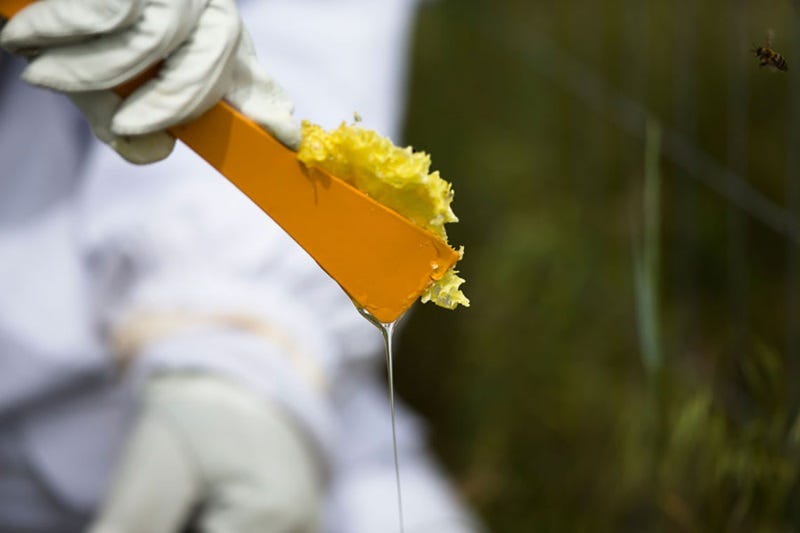
How to Harvest your Honey
Think of each cell in your full frame of comb as individual cups filled up and sealed with honey.
When you "uncap" them, essentially you are lifting the lids from those cups (and leaving the cup itself) so the honey can drain out. By uncapping these cells, there is less wax/comb that you need to worry about when you "filter" your honey.
Something else to consider is that there is less damage to the actual comb itself when you uncap them: that means when you put the frames back into the hive after extraction, the bees don't have to expel energy rebuilding that comb and can go right back to storing honey for winter!
If you live inside city limits, then you'll want to read this piece on bees.
So, you're ready to uncap your hives and go but wait. When you uncap your honey cells, you should use a spinner, because, without the centrifugal force generated by the honey spinner, it will take an interminably long time for your honey to drain.
Crushing your honeycomb to extract it is an easier way to go if you're looking to utilize gravity in your filtration process because more of the "cup" is broken, and the honey can easily drain through your filtration device.
If you are leaving an extra super on your hive for winter stores like we did last winter, then you can crush and strain with abandon, and still enjoy your raw honey.
Do you use the Spinner Extraction Method or the Crush & Strain Method?
Preparing for Winter... and Coming back for the Spring Bee Check
When we started this bee project at the beginning, it was with a mind to really get into the product lines and experience what it was to be a beekeeper.
For the Homestead Honey hive in the year you’ve read about above, it was a productive year, and we were able to harvest 25 pounds of honey. Now we just need to cover hive preparation and winter onset.
The hive check is the last step in a beekeeper's first season- to see if your colony survived winter, to see if you still had bees to work within the second year. With Mr. Roger's statement in the video at the beginning of this article "to expect 50% hive failure during winter", we were a little trepidatious especially considering as we opted to take the hands-off approach over winter and left an entire box of honey for the bees to eat no sugar water or additives, just natural wintering of the hive.
When we went out to check the hive, we cracked the propolis seal, and we found our bees and the queen, already laying eggs. It was a good sign, but there were some things we saw that everyone thinking about beekeeping should be aware of:
- We found uniforms of white matter along the bottom board of the hives at first we thought these could be mites or some other indication of hive health- but after careful inspection, we found out that those lines of debris were actually the remains of the "uncapping" process the bees do during winter when they are feeding. So if you see that debris when you check your hive after winter don't panic. It may just be a sign of a healthy hive!
- Another take away from our over-winter hive check: replace the boards you take off in the same position they were in all winter. Why? Imagine you are a bee in a bee apartment building you've learned where the stairs are, the rooms, the exits now imagine someone cracks open the building and rearranges the upper levels of your apartment building on backwards. When you reverse the boxes, it's called "checkerboarding" and could place undue stress on your bees, and right after winter when the hive population is small, that's something you want to avoid.
A Look back at our First Year of Beekeeping and what we Learned
The spring started out like any other spring in the Northwest: unpredictable. A new line of beekeeping equipment was keeping things equally unpredictable at the stores. Until then, we'd never sold anything like this and knew very little about what it took to become a backyard beekeeper.
As a company, we take great pride in the fact that we have people in our stores that truly know our products and can help you make the right decision when making a purchase. On the same hand, if we honestly don't know about something, we aren't afraid to admit it but will work hard to find you an answer from someone who does.
Most people get into a hobby slowly by researching, tagging along with someone who has "been there, done that", or quietly observing from afar. Opting for none of those, we took the "both feet in first" approach to this adventure of becoming beekeepers.
As we stumbled through the year, we found ourselves going back to our best source of information (a real beekeeper) and we could see the results taking shape as we added boxes and tended to our bees.
Before we knew it, the summer had flown by and our small package of bees had transformed into a healthy colony with enough honey to actually harvest. In one, short Montana summer, we were able to raise a healthy hive and harvest 25 pounds of honey. Currently, our hive is buzzing, and we are excited to learn more in our second season of beekeeping.
Shop all our Beekeeping Supplies Online.
What's After? Networking like a Bee
So now you have gear, flowering plants, full brood chambers, and supers- now what? Well besides preparing for winter again like the first year with bee feed and pollen patties (which you can get from us online here)...
Now it's time to get involved in the local bee community.
There are a range of social groups devoted specifically to beekeeping and bees. You can find a decent list here, but this list is far from complete, and if you know any local groups, please feel free to share them with us in the comments. We'd love to help get people connected.
Bees- this is the only way to go. Check out the groups below and get active!!
Find a beekeeping community near you:

